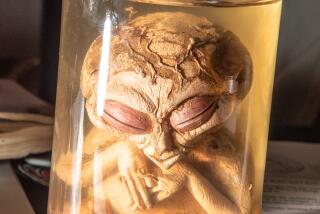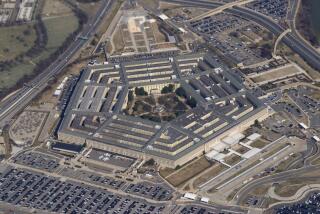UFOs, across the pond
It is one of the most memorable opening sequences on film: A small craft is being pursued through outer space by a massive triangular vessel, which passes over viewers’ heads with a roar that made audiences at screenings of “Star Wars,” in 1977, feel something like dolphins submerged under a passing aircraft carrier. So powerful was the image that it may have haunted some viewers’ dreams -- or waking visions.
We were reminded of this scene on Thursday when the British government released its fifth and largest collection of files about unidentified flying objects, which officials in Britain continued to monitor for years after the United States government stopped in 1969 (or claimed to have stopped -- some conspiracy theorists think there are still men in black keeping tabs on little green men). It’s fascinating stuff for lovers of the unexplained, loaded with stories of eerie lights in the sky, descriptions of vessels that defy the laws of physics, and warnings of alien viruses. One of the more compelling reports comes from a man in South Wales, who in January 1997 claimed that his car was enveloped by a beam of light while he was driving home at night. He emerged from the car to total silence, and began to feel ill. When the beam passed, his car was filthy and he developed a skin condition that required treatment.
Maybe it’s coincidental that the TV series “The X-Files,” which prominently featured alien abductions and viruses from outer space, was then a top-rated show on BBC2. Indeed, the British records, which detail sightings from 1994 to 2000, show that perceptions about UFOs might owe more to Hollywood than previously thought.
David Clarke, author of a book on the British UFO records, notes that the shapes of these objects have changed over time. In the 1940s and 1950s, UFOs were usually described by those who saw them as “flying saucers” -- round or disk-shaped objects. At the time, movies such as “The Day the Earth Stood Still” (1951) and “Forbidden Planet” (1956) reinforced the idea that futuristic spacecraft would look like Frisbees. Modern sightings, by contrast, involve different shapes, particularly triangles. Which is where that “Star Wars” sequence, and countless other Hollywood depictions of spaceships in all shapes and sizes, come in.
It’s worth noting that the most futuristic-looking of military aircraft, the Stealth bomber, is shaped like a triangle, so these perceptions aren’t necessarily or solely coming from Hollywood. But it does seem that when we see unusual and unexplainable lights in the sky, our brains leap to interpret them by forming familiar images of the sort we’ve been conditioned by science-fiction flicks to expect. That doesn’t mean people who see such things are crazy or that they’re hoaxers, only that they’re human.
More to Read
Only good movies
Get the Indie Focus newsletter, Mark Olsen's weekly guide to the world of cinema.
You may occasionally receive promotional content from the Los Angeles Times.










